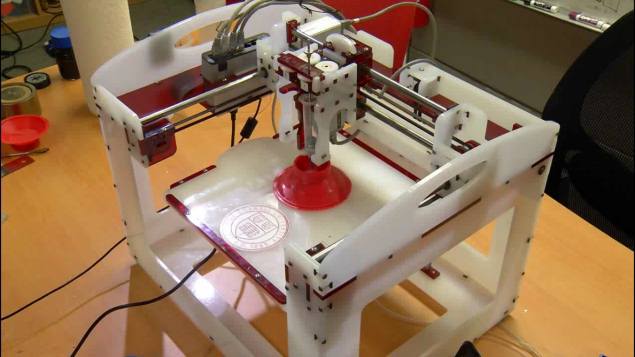- Home
- Laptops
- Laptops News
- Researchers 3D print working loudspeaker with new multi material method
Researchers 3D-print working loudspeaker with new multi-material method

The successful implementation of the new 3D printing technique implies that rather than assembling consumer products from parts and components, complete functioning products could be fabricated at once, on demand.
Kiran and Robert MacCurdy, graduate students in mechanical engineering, worked with Hod Lipson, associate professor of mechanical and aerospace engineering, to develop this unique technique, said a press release by Cornell University.
"Everything is 3D-printed," said Kiran, as he launched a demo by connecting the newly-printed mini speaker to amplifier wires.
For the demo, the amplifier played a clip from US president Barack Obama's 'State of the Union' speech that touch on 3D printing.
"A loudspeaker is a relatively simple object. It consists of plastic for the housing, a conductive coil and a magnet. The challenge is coming up with a design and the exact materials that can be co-fabricated into a functional shape," Kiran said.
Kiran used one of the lab's Fab@Homes - a customisable research printer that allows scientists to tinker with different cartridges, control software and other parameters.
For the conductor, Kiran used a silver ink. For the magnet, he employed the help of Samanvaya Srivastava, a graduate student in chemical and biomolecular engineering, to come up with a viscous blend of strontium ferrite.
After making a detailed digital model of the telegraph, they printed it on a research 'fabber'.
3D printing technology could be moving from printing passive parts toward printing active, integrated systems, added the release. But it will be a while before consumers are printing electronics at home.
Most printers cannot efficiently handle multiple materials. It's also difficult to find mutually compatible materials - for example, conductive copper and plastic coming out of the same printer require different temperatures and curing times.
Creating a market for printed electronic devices could be like introducing colour printers after only black and white had existed. "It opens up a whole new space that makes the old look primitive," the release added.
For the latest tech news and reviews, follow Gadgets 360 on X, Facebook, WhatsApp, Threads and Google News. For the latest videos on gadgets and tech, subscribe to our YouTube channel. If you want to know everything about top influencers, follow our in-house Who'sThat360 on Instagram and YouTube.
Related Stories
- Samsung Galaxy Unpacked 2025
- ChatGPT
- Redmi Note 14 Pro+
- iPhone 16
- Apple Vision Pro
- Oneplus 12
- OnePlus Nord CE 3 Lite 5G
- iPhone 13
- Xiaomi 14 Pro
- Oppo Find N3
- Tecno Spark Go (2023)
- Realme V30
- Best Phones Under 25000
- Samsung Galaxy S24 Series
- Cryptocurrency
- iQoo 12
- Samsung Galaxy S24 Ultra
- Giottus
- Samsung Galaxy Z Flip 5
- Apple 'Scary Fast'
- Housefull 5
- GoPro Hero 12 Black Review
- Invincible Season 2
- JioGlass
- HD Ready TV
- Laptop Under 50000
- Smartwatch Under 10000
- Latest Mobile Phones
- Compare Phones
- Infinix Note 50s 5G+
- Itel A95 5G
- Samsung Galaxy M56 5G
- HMD 150 Music
- HMD 130 Music
- Honor Power
- Honor GT
- Acer Super ZX Pro
- Asus ExpertBook P3 (P3405)
- Asus ExpertBook P1 (P1403)
- Moto Pad 60 Pro
- Samsung Galaxy Tab Active 5 Pro
- Oppo Watch X2 Mini
- Garmin Instinct 3 Solar
- Xiaomi X Pro QLED 2025 (43-Inch)
- Xiaomi X Pro QLED 2025 (55-Inch)
- Nintendo Switch 2
- Sony PlayStation 5 Pro
- Toshiba 1.8 Ton 5 Star Inverter Split AC (RAS-24TKCV5G-INZ / RAS-24TACV5G-INZ)
- Toshiba 1.5 Ton 5 Star Inverter Split AC (RAS-18PKCV2G-IN / RAS-18PACV2G-IN)

















